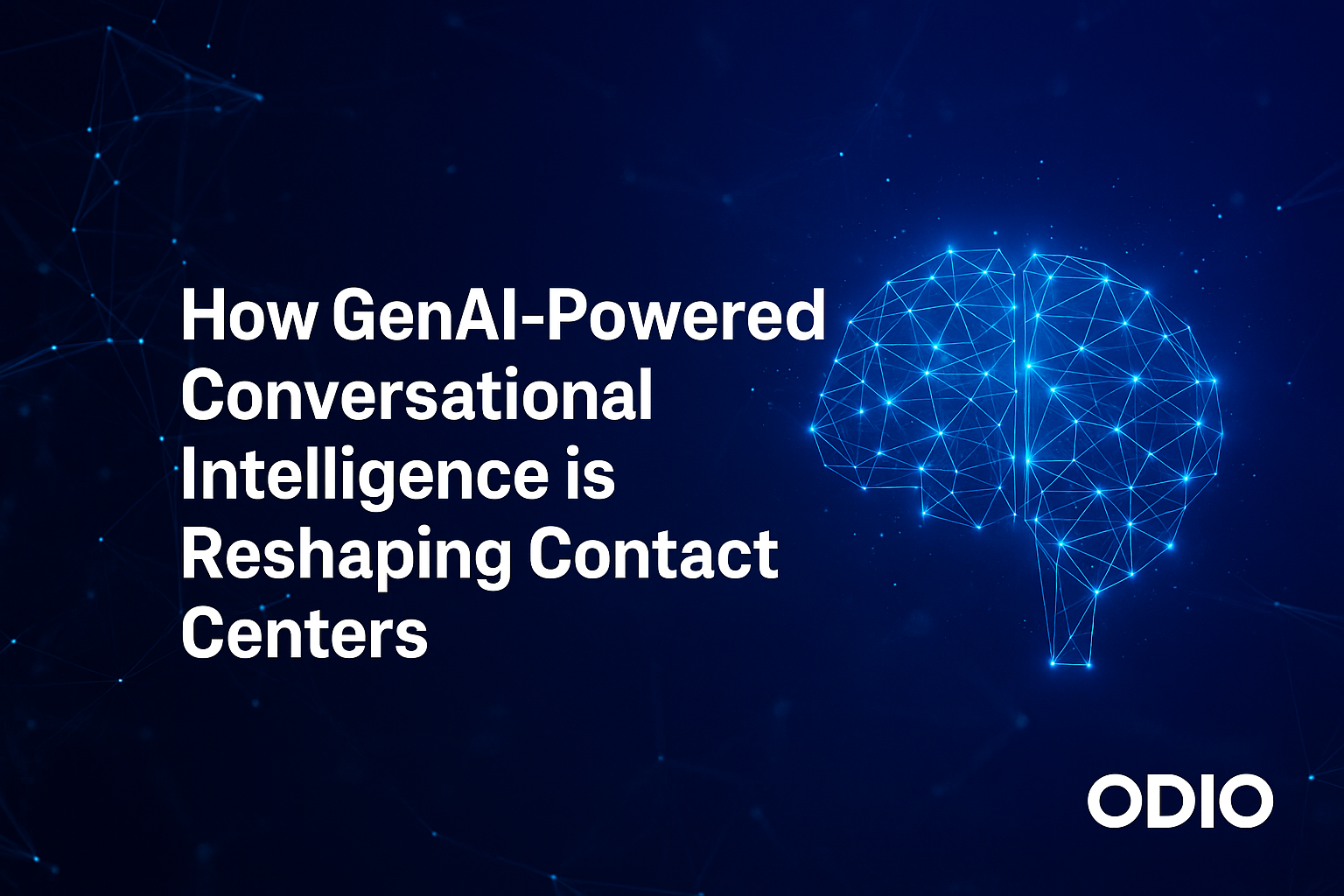
Introduction: From Automation to Collaboration
For years, contact centers have leaned on conversational platforms to streamline workflows—automating tasks and lowering costs. These systems perform predictably well when interactions stay structured and simple. But in real conversations—with emotion, surprise, complexity—traditional automation falters. It can follow scripts but doesn’t think. It responds but doesn’t adapt. ODIO believes the future isn’t automation—it’s collaboration.
1. The Limits of Conventional AI
- Static Responses: Legacy systems depend on precise rules. Change the script, and they break.
- Task-Focused, Not Thoughtful: They’re great at FAQs, not empathy.
- Fragmented Insight: You might know what happened but not why, when, or how it connects to the bigger picture.
When the conversation shifts, these tools stop being effective. That’s why ODIO pushes beyond: agentic AI doesn’t just operate, it participates.
2. The ODIO Agentic AI Advantage
ODIO’s agentic intelligence introduces a proactive layer a system that can interpret, decide, and engage autonomously.
It brings:
- Real-Time Adaptation: Reads mood, sentiment, context takes appropriate, dynamic action.
- Proactive Decision-Making: Identifies opportunities, executes tasks, and adjusts approach all without waiting for input.
- Continuous Learning: Every call, every interaction, helps the system improve—without manual reconfiguration.
This isn’t AI as silent support—it’s AI as intelligent collaborator.
3. How Agentic AI Works
Delving under the hood, here’s how ODIO’s system function:
- Contextual Awareness
- Reads tone, urgency, customer emotion—whether patience, frustration, or urgency.
- Pinpoints intent, even in partial or unclear queries.
- Strategic Decision-Making
- Weighs multiple paths (e.g., escalate, offer discount, transfer)—selects the most effective route.
- Balances outcomes like resolution speed, customer satisfaction, and cost-efficiency.
- Seamless Task Execution
- Executes follow-ups, populates CRM notes, initiates callbacks—without prompting.
- Integrates with systems like CRM, knowledge bases, dashboards for full-stack impact.
- Learning in Real Time
- Learns from every resolution—successful or not.
- Applies improvements and informs agents of patterns, best practices, and shortcuts.
4. From Theory to Transformation: Use Cases in Action
- Plain-Language Insights
- Business users type: “What’s trending in complaints this week?” ODIO’s agent returns analysis, correlations, and next-step recommendations—no SQL needed.
- Intelligent Agent Assist
- During a live call, the AI suggests in-line recommendations, knowledge snippets, or conversation tips—helping agents respond faster and more helpfully.
- Automated Post-Call Workflow
- As soon as the conversation wraps, the AI sends follow-up emails, updates CRM fields, and generates summary flags—so agents focus on people, not paperwork.
- Adaptive Customer Experience
- The AI tailors its style: calm if the customer is impatient, direct if time-constrained, or empathetic when handling complaints—mirroring human intuition.
5. Business Impact: What Makes Agentic AI Better
Agentic AI transforms operations on multiple fronts:
| Dimension | Traditional AI | ODIO Agentic AI |
|---|---|---|
| Efficiency | Reduces tasks | Automates actions end-to-end |
| Effectiveness | Limited to scripted paths | Handles unpredictable scenarios |
| Insights | Siloed metrics | Real-time, strategic decision support |
| Adaptability | Manual updates needed | Learns and evolves autonomously |
| Agent Experience | Canned responses | Intelligent assistance + transparency |
Beyond speed or cost, it’s about reshaping how contact centers operate—making them smarter, more responsive, and more resilient.
6. Getting Started with Agentic AI—The ODIO Way
Adopting this isn’t plug-and-play. Here’s how to roll it out:
- Define Use Cases
- Select high-impact scenarios—complex queries, support escalations, or form-intensive workflows.
- Pilot Strategically
- Start small. Run live pilot programs, iterate, get feedback and refine before broader rollout.
- Embed Human Oversight
- Keep humans in the loop—especially during early stages. Let agentic AI suggest, not mandate.
- Govern Thoughtfully
- Implement checks, escalation paths, and fail-safes. Measure outcomes—not just automation rates, but satisfaction and accuracy.
- Scale Gradually
- Expand from pilot lanes to full contact center integration. Always iterate with agents and leaders as partners.
7. Looking Forward: What’s Next
Agentic AI is still evolving, but the trends are clear:
- Enterprises will shift from asking “can we automate?” to “what can AI independently handle?”
- Contact centers will become hybrid workspaces of human-AI collaboration.
- Governance, explainability, and transparency will become growth enablers—not compliance checks.
ODIO is helping design this future—with agentic systems that don’t work for you—they work with you.
Conclusion
Agentic AI isn’t a buzzword—it’s a paradigm shift. For contact centers, it’s not about automation efficiency—it’s about transformation intelligence: systems that reason, act, and learn alongside your teams.
If you’re ready to elevate contact center operations from reactive to proactive, ODIO is ready to lead you there.

